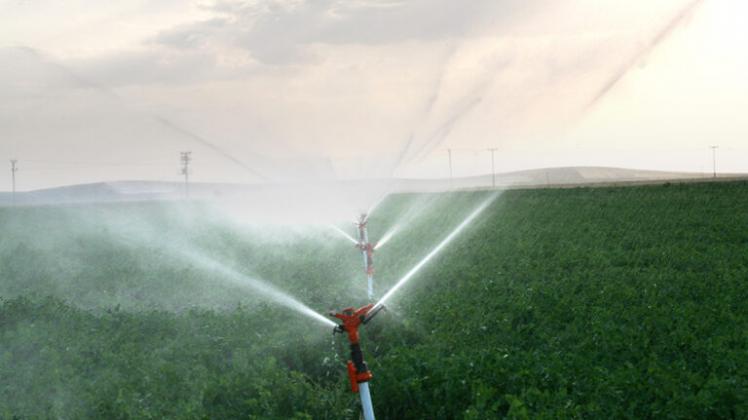EEUU: Agreement settles water rift in nation’s top potato-producing state
New deal gives groundwater users water allotment in four-year increments

Irrigation water is the lifeblood of agriculture in the Western states. Early settlers had to divert water from streams and rivers or dig canals to bring the vital resource to farms from reservoirs.
Water is particularly important — and can be a contentious issue — in the country’s top potato-growing state.
Water use in Idaho, which produced 145 million bushels of potatoes in 2023 and sees growers harvest between 300,000 and 320,000 acres each year, is governed by the doctrine of prior appropriation. The doctrine gives senior water rights holders (the first users of the water) priority over junior rights holders. During periods of scarcity, senior rights holders can use all of the water allotted to them, while junior users may receive some or none of their allotment.
With a water shortage projected earlier this year, the Idaho Department of Water Resources (IDWR) issued a restraining order requiring 6,400 junior water rights holders who pump water from the Eastern Snake Plain aquifer to shut off their water supply. At the time of the May 30 order, the department projected that senior water rights users in the Twin Falls Canal Co. could face a water shortage of 74,100 acre-feet.
An acre-foot is a unit of volume that measures the amount of water it would take to cover one acre of land with water one foot deep.
Owners of up to 500,000 acres in eastern Idaho who are at risk of being deprived of water have protested. Many irrigators have had to shut off water supplies in the middle of the growing season.
The restraining order remained in effect for three weeks until an agreement was reached to end it in 2024. Idaho Gov. Brad Little issued an executive order requiring a new long-term agreement to be reached by Oct. 1.
In November, members of the Idaho Surface Water Coalition and the Idaho Groundwater Association ratified a long-term agreement. The new agreement gives groundwater users their water allocation in four-year increments rather than determining allocations one year at a time. It also requires groundwater districts to conserve a minimum of 205,000 acre-feet of water annually.
“It was a difficult year of negotiations, but I never doubted that our farmers could get it done,” Little said in a written statement. “Idahoans have always solved our own problems, and the new mitigation plan charts a better path for all water users in the years ahead, while ensuring Idahoans remain in control of our water destiny.”
FIRST IN TIME, FIRST IN LAW
The history of water in Idaho is complicated. Each water right has a date on which it was applied for and the land was assigned to the property. The doctrine of prior appropriation established priority and subordinate water rights, also known as "first in time, first in right."
Furthermore, the state’s irrigation water is managed as a single resource, with surface water and groundwater managed together.
“If a prior right is being harmed by a later right, the later right has to cut off or shut off supply until the prior right has its water,” said Scott Bedke, a farmer/rancher and lieutenant governor of Idaho. “This can be detrimental to the local economy when strictly applied without modification. The only thing that can be done legally to modify the prior allocations doctrine is to create mitigation plans.”
Personal relationships can also be affected. Imagine that the original owner of Property A moved into the area 140 years ago, settled at the lower end of a valley with a stream running through it, and established the first water right, irrigating with that stream. The first owners of Property B settled at the top of the valley 10 years later.
“The families have lived together for decades, their children have married and they have become a community,” Bedke said. “But the people on Farm B know that if Farm A needs water, Farm B must cut off its supply or reduce its use to satisfy Farm A’s right.”
If farm owners find ways to resolve the problem, that mitigation plan is submitted to IDWR, whose director must approve it.
“If we do the things on the list, irrigators will get a safe haven from the harshness of prior appropriation; the mitigation plan protects people from having to suddenly have their water shut off,” Bedke said.
Those plans are becoming more complicated as more irrigators join in. Bedke and co-mediator Jeff Raybould, chairman of the IDWR board, created a mitigation plan in 2009 and again in 2016.
The most recent version, the 2024 Mitigation Plan entered into with nine groundwater districts across the Eastern Snake Plain aquifer, features four key components:
PROPORTIONALITYUnder the 2016 agreement, everyone had to follow mitigation steps. “The nine groundwater districts were stuck with each other; if one didn’t comply, the others had to step up or they all broke the agreement and everyone was penalized,” Bedke said. “That was unfair. So we created a system where if one does their part, they get safe harbor, and if I don’t do my part, I suffer all the consequences of not complying with the agreement.”
“When you have fulfilled your responsibility, you will acquire your prorated share.”
RECHARGERecharge occurs when water seeps into the ground to replenish underground aquifers. Although some recharge occurs accidentally, intentional recharge can restore groundwater levels and store water for later use.
“The 205,000 acre-feet reduction in pumping leaves me with a certain amount that I can pump,” Bedke said. “I want to be able, through my own means, to improve my allocation. That’s where private recharge comes in. However, not all recharge is created equal.”
Senior rights holders experience leaching gain between Blackfoot and Minidoka, with Twin Falls Canal Co. water entering the river between those two areas, he said.
“To get credit to increase their allocation, they need to recharge in an area where the water will go into the river and is connected and hydrologically significant to that leaching gain,” Bedke said. “If they can do this, they get credit for private recharge, which can increase their allocation.”
AVERAGECrop rotation and water requirements of different crops also play a role.
“If I’m going to put water into the aquifer in a good year so I can take it out in a bad year, I have to be able to average out my water use,” Bedke said. “It’s simple math, but it’s never simple because one year I grow barley and the next year I grow potatoes.”
The four-year increments allotted in the new agreement may influence decisions on crop rotation.
“Having a four-year water block allows management decisions to be made at the farm level rather than at the state or water district level,” Bedke said. “The farmer gets a water block and can choose to use maybe 20% of it one year and 35% of it the next year. But when it’s gone, it’s gone.”
MEASUREMENTThe four-year allocations make accurate and transparent data collection of paramount importance, “so that everyone knows where neighbors stand in their water use and farm managers know where they stand in terms of allocations,” Bedke said.
Future water use could also be affected by other factors, including projects currently underway, such as drilling recharge wells or managed recharge programs that convert groundwater farms to surface water farms.
“All of this will help,” Bedke said. “There won’t be one answer; there may be 100 answers on how to do it. Every locality has some unique things it can do.”
Four-year water block allocations create a de facto trial period that can help make the path forward clearer, he said.
“We’ll see how it goes over those four years and if it goes well, the agreement will be extended for another four years, and so on,” Bedke said. “We can revisit it every four years to make sure it’s working.”
Fuente: spudman.com




